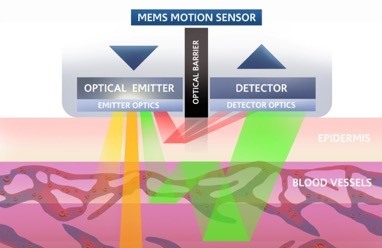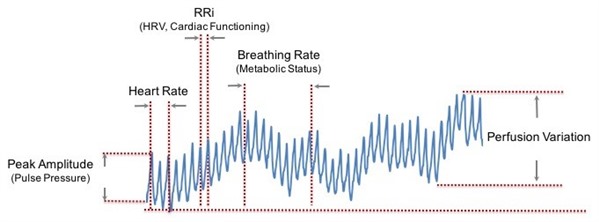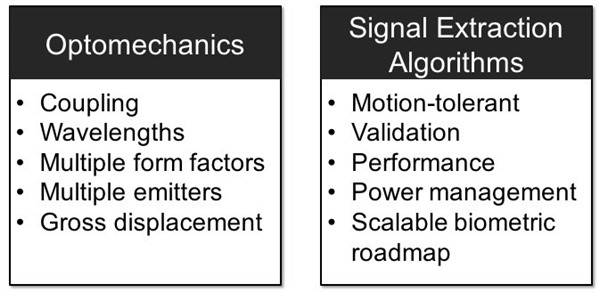SSZT726 May 2018 AFE4410
This is the first in a three-part series on optical heart rate sensors for biometric wearables. This first installment focuses on how these sensor systems work and what you can measure with them.
Most wearables use photoplethysmography (PPG) to measure heart rate and other biometrics. PPG is the methodology of shining light into the skin and measuring the amount that scatters based on blood flow. That’s an oversimplification, but optical heart-rate sensors work based on the fact that light entering the body will scatter predictably as the blood-flow dynamics change, such as with changes in blood pulse rates (heart rate) or changes in blood volume (cardiac output). Figure 1 below depicts the primary components and basic working methodology of an optical heart rate sensor.
 Figure 1 Optical Heart Rate Sensor’s
Basic Structure and Operation
Figure 1 Optical Heart Rate Sensor’s
Basic Structure and OperationOptical heart-rate sensors use four primary technical components to measure heart rate:
- Optical emitters – generally comprising at least two light-emitting diodes (LEDs) that send light waves into the skin.
- A photodiode and analog front end (AFE) – these components capture the light refracted from the wearer and translate those analog signals into digital signals for calculating meaningful heart-rate data. After evaluating all AFE options on the market, Valencell selected the TI AFE4410 in its next-generation Benchmark sensor system.
- Accelerometer – the accelerometer measures motion and is used in combination with the light signals as inputs into PPG algorithms.
- Algorithms – the algorithms process the signals from the AFE and accelerometer into a PPG waveform, which can generate continuous, motion-tolerant heart-rate data and other biometrics.
What Can an Optical Heart-rate Sensor Measure?
 Figure 2 Typical PPG Waveform
Figure 2 Typical PPG WaveformHere’s further detail on some of the measurements possible with optical heart rate sensors:
- Breathing rate – lower resting breathing rates generally correlate with higher levels of fitness.
- VO2 max – VO2 measures the maximum volume of oxygen someone can use and is widely considered an indicator of aerobic endurance.
- Blood oxygen levels (SpO2) – blood oxygen levels indicate the concentration of oxygen in the blood.
- R-R interval (heart-rate variability) – The R-R interval is the time between blood pulses; generally, the more varied the time between beats, the better. R-R interval analysis can be used as an indicator of stress levels and various cardiac issues.
- Blood pressure – it is now possible to measure blood pressure without a cuff using PPG sensor signals. Here’s a link to a demo of Valencell’s technology measuring blood pressure.
- Blood perfusion – Perfusion refers to the body’s ability to move blood through the circulatory system, particularly in extremities and in the capillary beds throughout the body. Because PPG sensors track blood flow, it’s possible to measure blood relative blood perfusion and changes in blood perfusion levels.
- Cardiac efficiency – this is another indicator of cardiovascular health and fitness that typically measures how efficiently the heart works to take one step.
Optical Heart Rate Sensor Challenges
 Figure 3 Primary Challenges When
Integrating Optical Heart Rate Sensors
Figure 3 Primary Challenges When
Integrating Optical Heart Rate SensorsOptomechanics
- Optomechanical coupling – is light guided and coupled to and from the body effectively in the device? This is critical to maximize the blood-flow signal and minimize environmental noise (such as sunlight) that can add noise to the sensor.
- Are the right wavelengths being used for the body location? Different wavelengths are required, in part because of the different physiological makeup of the body at different locations and because of the impact of environmental noise at different locations.
- Does the design use multiple emitters and are they spaced apart correctly? The spacing of emitters is important in order to ensure that you are measuring enough of the right kind of blood flow and fewer motion artifacts.
- Are the mechanics such that displacement between the sensor and the skin is minimal during exercise or body motion? This can be a problem for many common wearable activities, such as running, jogging and gym exercises.
Signal-extraction Algorithms
- Have the algorithms been validated on a diverse population set? It’s important to make sure that the device works on multiple skin tones, both genders, different body types and fitness levels, etc.
- Are the algorithms robust against multiple types of motion noise? The algorithms must be able to work during different activities, including walking, running (high-speed steady runs and interval training), sprinting, gym workouts, and everyday life actions like typing or riding in a vehicle.
- Are the algorithms continually improving to handle more use cases and new biometrics? This technology and the wearables market are advancing rapidly and you must continue to innovate to meet ongoing customer requirements.
I hope this post provided some insight on how PPG sensor systems operate and what they can measure. In the next post in this series, I’ll explore best practices in integrating this technology into devices of all kinds – watches, fitness bands, earbuds and more.
Additional Resources
- See TI’s photodiode sensing portfolio.
- Find resources and reference designs for wearables here.